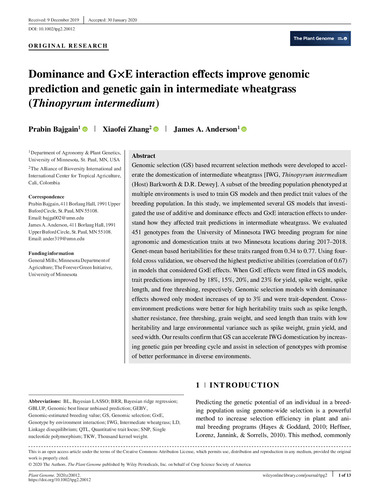Dominance and G×E interaction effects improvegenomic prediction and genetic gain inintermediate wheatgrass (Thinopyrumintermedium)
Genomic selection (GS) based recurrent selection methods were developed to accelerate the domestication of intermediate wheatgrass [IWG, Thinopyrum intermedium (Host) Barkworth & D.R. Dewey]. A subset of the breeding population phenotyped at multiple environments is used to train GS models and then predict trait values of the breeding population. In this study, we implemented several GS models that investigated the use of additive and dominance effects and G×E interaction effects to understand how they affected trait predictions in intermediate wheatgrass. We evaluated 451 genotypes from the University of Minnesota IWG breeding program for nine agronomic and domestication traits at two Minnesota locations during 2017–2018. Genet-mean based heritabilities for these traits ranged from 0.34 to 0.77. Using fourfold cross validation, we observed the highest predictive abilities (correlation of 0.67) in models that considered G×E effects. When G×E effects were fitted in GS models, trait predictions improved by 18%, 15%, 20%, and 23% for yield, spike weight, spike length, and free threshing, respectively. Genomic selection models with dominance effects showed only modest increases of up to 3% and were trait-dependent. Crossenvironment predictions were better for high heritability traits such as spike length, shatter resistance, free threshing, grain weight, and seed length than traits with low heritability and large environmental variance such as spike weight, grain yield, and seed width. Our results confirm that GS can accelerate IWG domestication by increasing genetic gain per breeding cycle and assist in selection of genotypes with promise of better performance in diverse environments.

